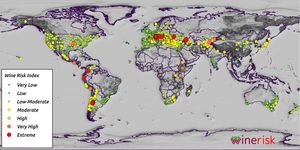Combining the impacts of all natural hazards that occur in a wine region, a general risk index has been created for each region. This is based on the areas with the highest risk as well as the main threats that have been seen.
Highest Risk due to Natural Hazards in Wine Regions Overall
-
Mendoza, Argentina and San Juan, Argentina
-
Kakheti & Racha, Georgia
-
Cahul (Southern), Moldova
-
Slovenia (Primorje – West)
-
Yaruqui Valley, Ecuador; Nagano, Japan
Top wine producers and their main threats in recent years
Global production in 2023 was 23.7 billion litres according to the OIV preliminary figures, while consumption was 22.1 billion litres. The production in 2022 was 26.3 billion litres.
-
Italy: 4.9 billion litres (2022, OIV) reduced to 3.83 billion litres in 2023. Hail, frost and earthquake normally play a role (although volcano, flash flood, flood and climatic effects also can play a role), and 2023 had large mildew issues after heavy rainfall, flooding and hailstorms.
-
France: 4.6 billion litres (2022, OIV) – Frost, hail, storm usually play a role. 2023 was a good year, with an increase to 4.8 billion litres despite diseases in Bordeaux.
-
Spain: 3.6 billion litres (2022, OIV) – NW Hail, Frost, Heat; reduced in 2023 to 2.8 billion litres with extreme drought and temperatures affecting yields.
-
United States: 2.24 billion litres (2022, OIV) – Frost, Earthquake, Storm; however in 2023 increased to 2.43 billion litres with good winter rainfall and cooler temperatures.
-
Australia: 1.31 billion litres (2022, OIV) – Frost, Storm, Hail, Bushfire; likely reduced to 960 million litres – rain, cool temperatures, flooding, disease; and some fruit not being harvested (Wine Australia, 2024).
-
Chile: 1.24 billion litres (2022, OIV) – Bushfires, Drought, Flooding, Earthquake; reduced to 1.1 billion litres in 2023 due to bushfires, drought and flooding.
-
Argentina: reduced from 1.15 billion litres in 2022 to 880 million litres, with frost and hail playing a major role after big heatwaves in February.
-
South Africa also had disease issues with their yield in 2023 expected also under 1 billion litres.


